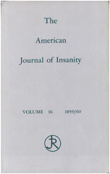Obsessive-compulsive disorder among patients with anorexia nervosa and bulimia nervosa
Abstract
OBJECTIVE: The present study sought to determine the prevalence of obsessive-compulsive disorder among patients with eating disorders. METHOD: Ninety-three women who met DSM-III-R criteria for anorexia nervosa or bulimia nervosa were investigated by using a semistructured diagnostic interview, the Yale-Brown Obsessive Compulsive Scale, and the Eating Disorder Inventory. RESULTS: Thirty-four patients (37%) met the DSM-III-R criteria for obsessive-compulsive disorder and also had a clinically significant score of 16 or higher on the Yale-Brown scale. These patients also had significantly higher, and hence pathological, mean scores on five of eight Eating Disorder Inventory scales than patients with eating disorders without concomitant obsessive-compulsive disorder. CONCLUSIONS: These results suggest that there is a high prevalence of obsessive-compulsive disorder among patients with anorexia and bulimia nervosa and that this prevalence may be correlated with the severity of the eating disorder.
Access content
To read the fulltext, please use one of the options below to sign in or purchase access.- Personal login
- Institutional Login
- Sign in via OpenAthens
- Register for access
-
Please login/register if you wish to pair your device and check access availability.
Not a subscriber?
PsychiatryOnline subscription options offer access to the DSM-5 library, books, journals, CME, and patient resources. This all-in-one virtual library provides psychiatrists and mental health professionals with key resources for diagnosis, treatment, research, and professional development.
Need more help? PsychiatryOnline Customer Service may be reached by emailing [email protected] or by calling 800-368-5777 (in the U.S.) or 703-907-7322 (outside the U.S.).



